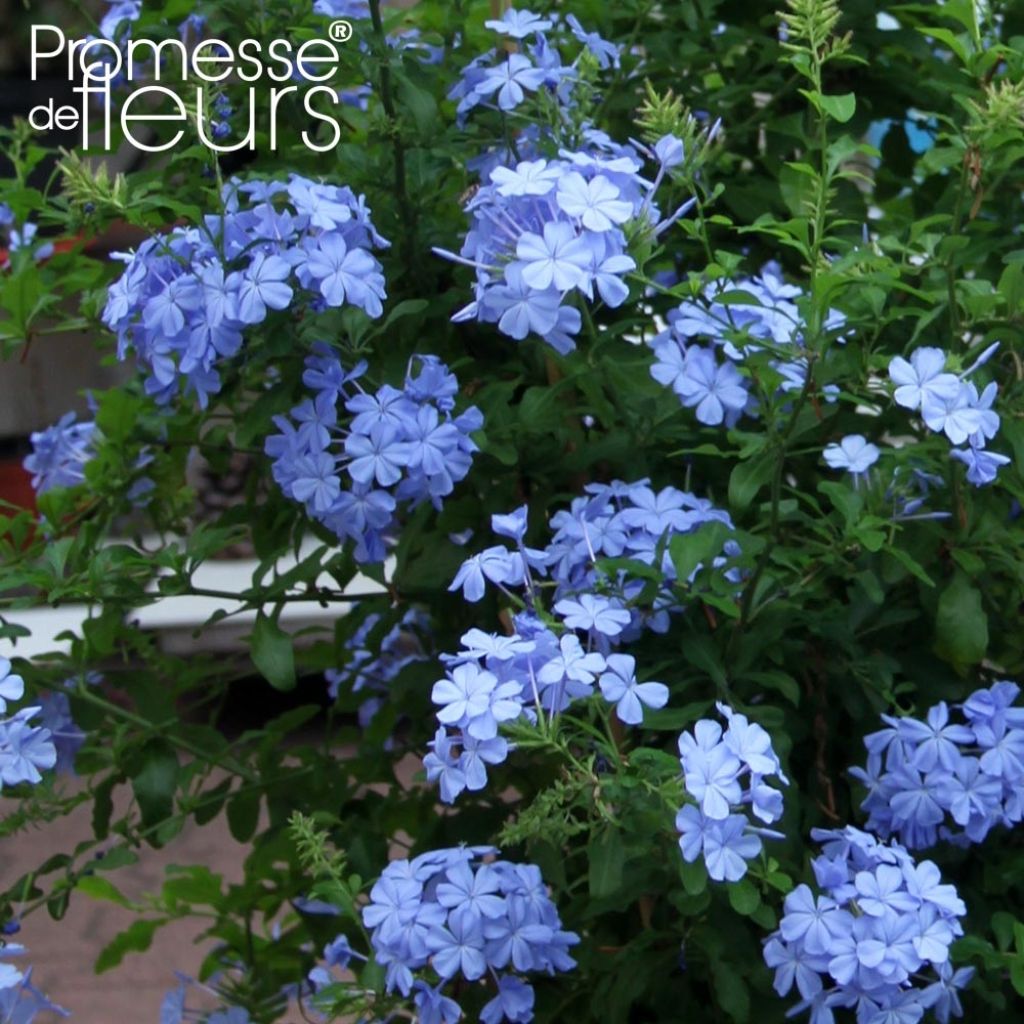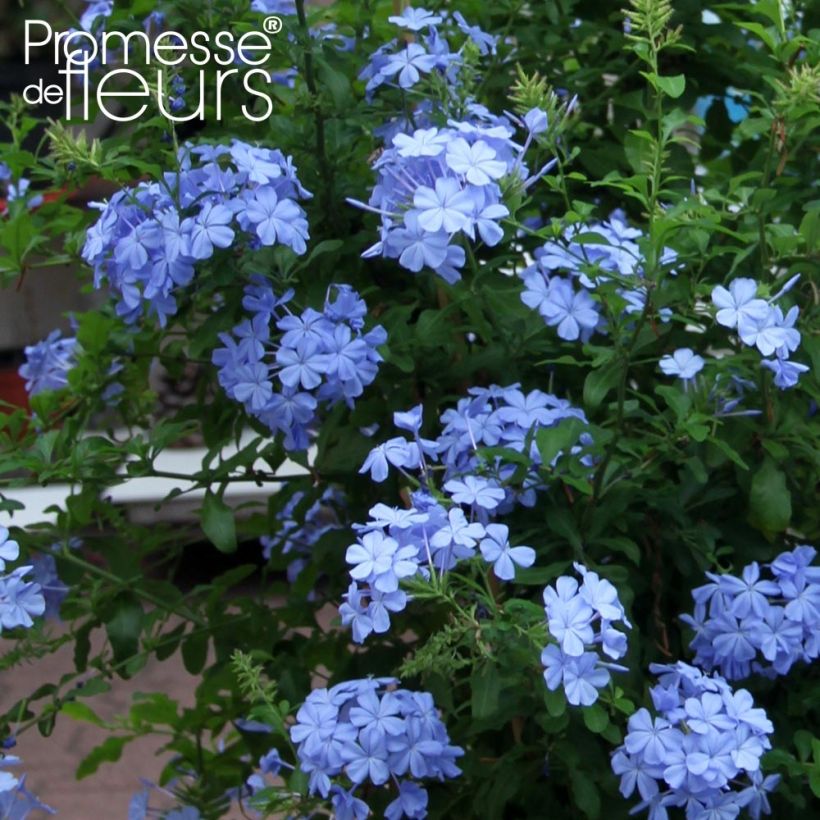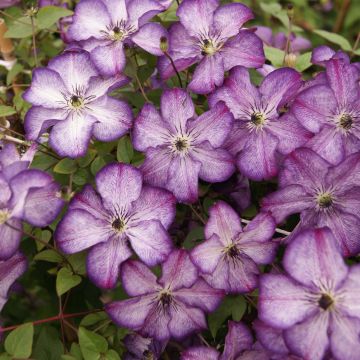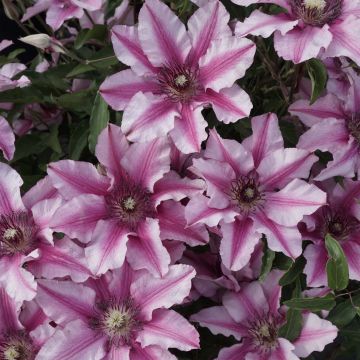

Plumbago auriculata Dark Blue


Plumbago auriculata Dark Blue


Plumbago auriculata Dark Blue
Plumbago auriculata Dark Blue
Plumbago auriculata Dark Blue
Cape Leadwort, Blue Plumbago
This plant carries a 6 months recovery warranty
More information
We guarantee the quality of our plants for a full growing cycle, and will replace at our expense any plant that fails to recover under normal climatic and planting conditions.
From €5.90 for pickup delivery and €6.90 for home delivery
Express home delivery from €8.90.
Does this plant fit my garden?
Set up your Plantfit profile →
Description
The Plumbago auriculata 'Dark Blue' or Cape Leadwort is a exuberant semi-climbing bush, popular among gardeners in mild regions, where frost does not occur too strongly or for too long. This plant, native to South Africa, loves the sun and needs warmth to provide its endless flowering, which hids the foliage for many months under a cloud of deep blue. This shade, which is actually quite rare among summer and autumn flowering bushes, wonderfully accompanies all the other shades of the garden, even late in the season. As it is not very hardy, it should be grown in a pot so that it can be brought indoors to a greenhouse at the first signs of cold weather outside the Mediterranean or Atlantic coast.
The Plumbago auriculata, Cape Leadwort, was recently called Plumbago capensis, due to its origins in the Cape region. It belongs to the family Plumbaginaceae and is a cousin of Armeria and Ceratostigma. Part bush-like and part climbing, with flexible branches, the Cape Leadwort quickly reaches a height of 2.50 to 4 m (8 to 13ft) and spreads 2.50 m (8ft) when not cut back by the cold. In a pot, its dimensions will remain more modest, around 1.50 m (5ft) in height and 1 m (3ft) in width. Its habit is dense, rounded, and a bit unruly if not trained against a wall. The flowering of this plant is its main asset: it starts in July and only ends with the first frosts. The bush then disappears under a multitude of intense blue panicles that succeed each other at the end of the branches, accompanying the growth. Each bouquet, 10 to 15 cm (4 to 6in) long, is composed of dozens of small flowers with 5 fused petals, 2 to 4 cm (1 to 2in) long, resembling those of phlox, with a calyx covered in sticky glandular hairs. The leaves, evergreen in mild climates, are entire, oblong, light green and vivid, measuring about 5 cm (2in) in length and 2 cm (1in) in width.
The Plumbago auriculata 'Dark Blue' adapts to all applications and proves to be an easy bush to cultivate, in the ground or in pots, after careful installation, as long as it is not lacking in food, water, or sunlight. It can be used in a mass planting or as a standalone plant in a warm location, or as a ground cover where it will form a beautiful mass, or even trained on a support such as a trellis or a fence. Some gardeners also install it at the top of a retaining wall to admire its cascade of sky blue flowers, so soothing under the July sun. The neutral and pastel colour of its flowers easily pairs with many flowering bushes in mild climates: the bright orange flowers of Sesbania punicea, the mauve flowers of Melaleuca gibbosa, the white flowers of Gomphostigma virgatum, the red flowers of ivy geraniums or dwarf pomegranate, or even the yellow flowers of oleander. The Indian lilacs, in all their splendor at the height of summer, will create a beautiful ensemble with vibrant colours.
Report an error about the product description
Plumbago auriculata Dark Blue in pictures




Plant habit
Flowering
Foliage
Botanical data
Plumbago
auriculata
Dark Blue
Plumbaginaceae
Cape Leadwort, Blue Plumbago
Cultivar or hybrid
Other Plumbago - Cape Leadwort
Planting and care
Growing Plumbagos in open ground is risky outside of our privileged Mediterranean or Atlantic regions. It is not difficult in a sheltered location, as long as winter temperatures rarely go below -8°C (17.6°F) and only for short periods. A well-established plant is capable of regenerating quickly from the stump in spring. In open ground, the plant requires warmth and light, which will boost growth in spring and allow flowering to begin as early as June-July. The soil that accommodates the Cape Plumbago should be loose, deep, fertile, and regularly amended. Its resistance to drought is proven, but regular watering will greatly improve the appearance of the bush and its flowers. Lastly, this bush is sensitive to excess limestone in the soil and irrigation water. If its foliage turns yellow, it is due to excessive limestone causing chlorosis: treat preventively with a chelate in spring, and then during summer. If a slightly harsher winter has cut back all vegetation, prune the branches to 15 cm (6in) from the ground in March.
You can easily cultivate Plumbagos in pots in a warm and bright location, ideally in a greenhouse. Provide them with a rich substrate. You can take them outside when the outside temperature is sufficient. Bring them inside at the beginning of autumn when temperatures start to drop. During the growth period, water two to three times a week and provide liquid fertiliser at least every 15 days for good flowering. Reduce watering in winter.
Few pests attack this plant in our climates, unless it is cultivated in a greenhouse: watch out for the appearance of scale insects, whiteflies, and red spider mites, which enjoy warm, dry, and confined atmospheres.
Planting period
Intended location
Care
-
, onOrder confirmed
Reply from on Promesse de fleurs
Summer flowering climbers
Haven't found what you were looking for?
Hardiness is the lowest winter temperature a plant can endure without suffering serious damage or even dying. However, hardiness is affected by location (a sheltered area, such as a patio), protection (winter cover) and soil type (hardiness is improved by well-drained soil).

Photo Sharing Terms & Conditions
In order to encourage gardeners to interact and share their experiences, Promesse de fleurs offers various media enabling content to be uploaded onto its Site - in particular via the ‘Photo sharing’ module.
The User agrees to refrain from:
- Posting any content that is illegal, prejudicial, insulting, racist, inciteful to hatred, revisionist, contrary to public decency, that infringes on privacy or on the privacy rights of third parties, in particular the publicity rights of persons and goods, intellectual property rights, or the right to privacy.
- Submitting content on behalf of a third party;
- Impersonate the identity of a third party and/or publish any personal information about a third party;
In general, the User undertakes to refrain from any unethical behaviour.
All Content (in particular text, comments, files, images, photos, videos, creative works, etc.), which may be subject to property or intellectual property rights, image or other private rights, shall remain the property of the User, subject to the limited rights granted by the terms of the licence granted by Promesse de fleurs as stated below. Users are at liberty to publish or not to publish such Content on the Site, notably via the ‘Photo Sharing’ facility, and accept that this Content shall be made public and freely accessible, notably on the Internet.
Users further acknowledge, undertake to have ,and guarantee that they hold all necessary rights and permissions to publish such material on the Site, in particular with regard to the legislation in force pertaining to any privacy, property, intellectual property, image, or contractual rights, or rights of any other nature. By publishing such Content on the Site, Users acknowledge accepting full liability as publishers of the Content within the meaning of the law, and grant Promesse de fleurs, free of charge, an inclusive, worldwide licence for the said Content for the entire duration of its publication, including all reproduction, representation, up/downloading, displaying, performing, transmission, and storage rights.
Users also grant permission for their name to be linked to the Content and accept that this link may not always be made available.
By engaging in posting material, Users consent to their Content becoming automatically accessible on the Internet, in particular on other sites and/or blogs and/or web pages of the Promesse de fleurs site, including in particular social pages and the Promesse de fleurs catalogue.
Users may secure the removal of entrusted content free of charge by issuing a simple request via our contact form.
The flowering period indicated on our website applies to countries and regions located in USDA zone 8 (France, the United Kingdom, Ireland, the Netherlands, etc.)
It will vary according to where you live:
- In zones 9 to 10 (Italy, Spain, Greece, etc.), flowering will occur about 2 to 4 weeks earlier.
- In zones 6 to 7 (Germany, Poland, Slovenia, and lower mountainous regions), flowering will be delayed by 2 to 3 weeks.
- In zone 5 (Central Europe, Scandinavia), blooming will be delayed by 3 to 5 weeks.
In temperate climates, pruning of spring-flowering shrubs (forsythia, spireas, etc.) should be done just after flowering.
Pruning of summer-flowering shrubs (Indian Lilac, Perovskia, etc.) can be done in winter or spring.
In cold regions as well as with frost-sensitive plants, avoid pruning too early when severe frosts may still occur.
The planting period indicated on our website applies to countries and regions located in USDA zone 8 (France, United Kingdom, Ireland, Netherlands).
It will vary according to where you live:
- In Mediterranean zones (Marseille, Madrid, Milan, etc.), autumn and winter are the best planting periods.
- In continental zones (Strasbourg, Munich, Vienna, etc.), delay planting by 2 to 3 weeks in spring and bring it forward by 2 to 4 weeks in autumn.
- In mountainous regions (the Alps, Pyrenees, Carpathians, etc.), it is best to plant in late spring (May-June) or late summer (August-September).
The harvesting period indicated on our website applies to countries and regions in USDA zone 8 (France, England, Ireland, the Netherlands).
In colder areas (Scandinavia, Poland, Austria...) fruit and vegetable harvests are likely to be delayed by 3-4 weeks.
In warmer areas (Italy, Spain, Greece, etc.), harvesting will probably take place earlier, depending on weather conditions.
The sowing periods indicated on our website apply to countries and regions within USDA Zone 8 (France, UK, Ireland, Netherlands).
In colder areas (Scandinavia, Poland, Austria...), delay any outdoor sowing by 3-4 weeks, or sow under glass.
In warmer climes (Italy, Spain, Greece, etc.), bring outdoor sowing forward by a few weeks.














































